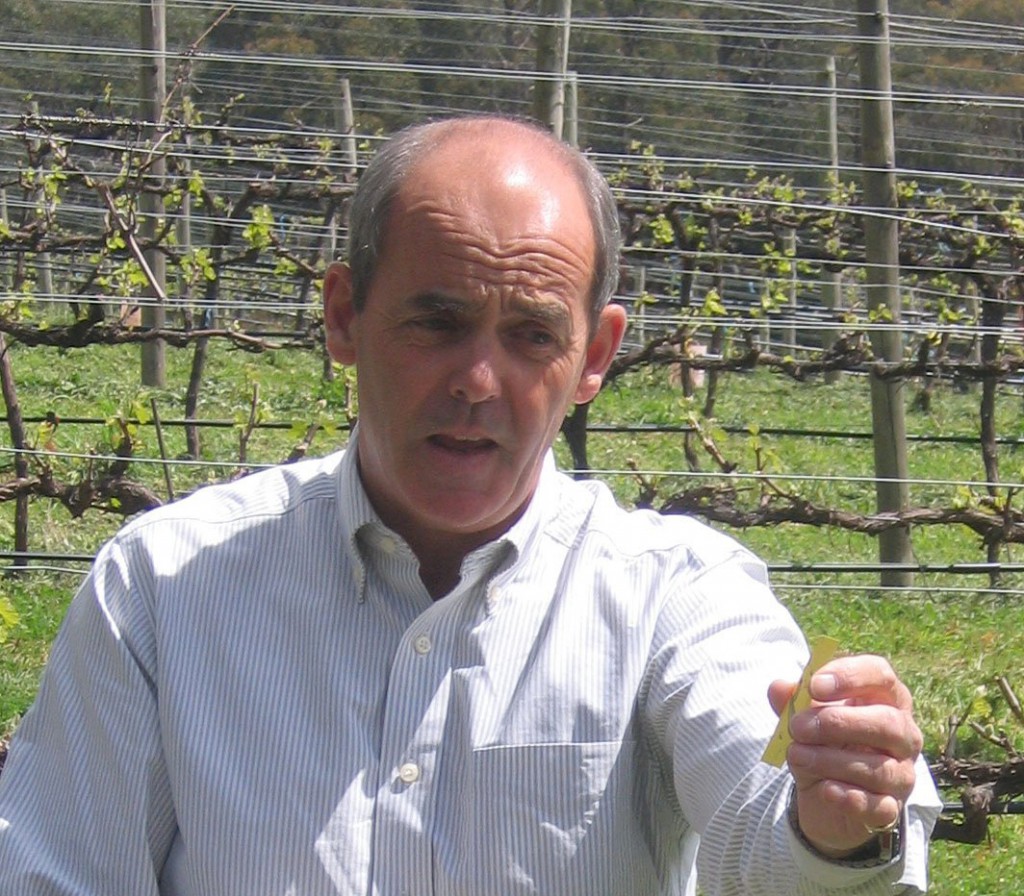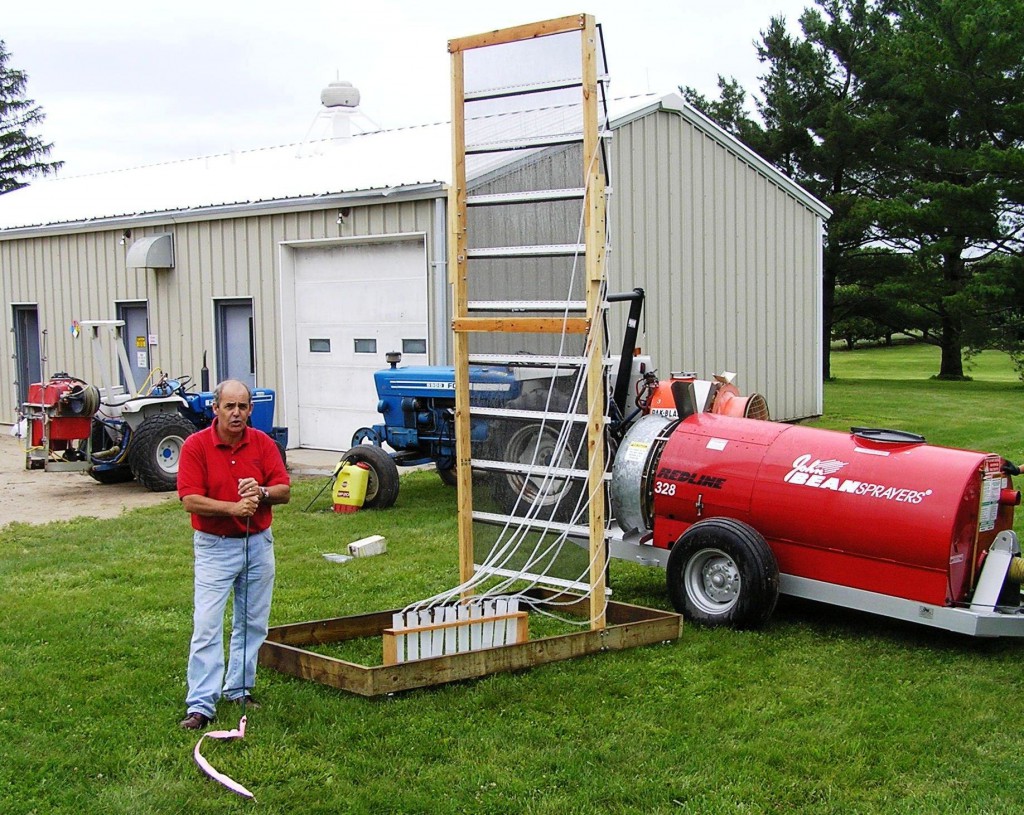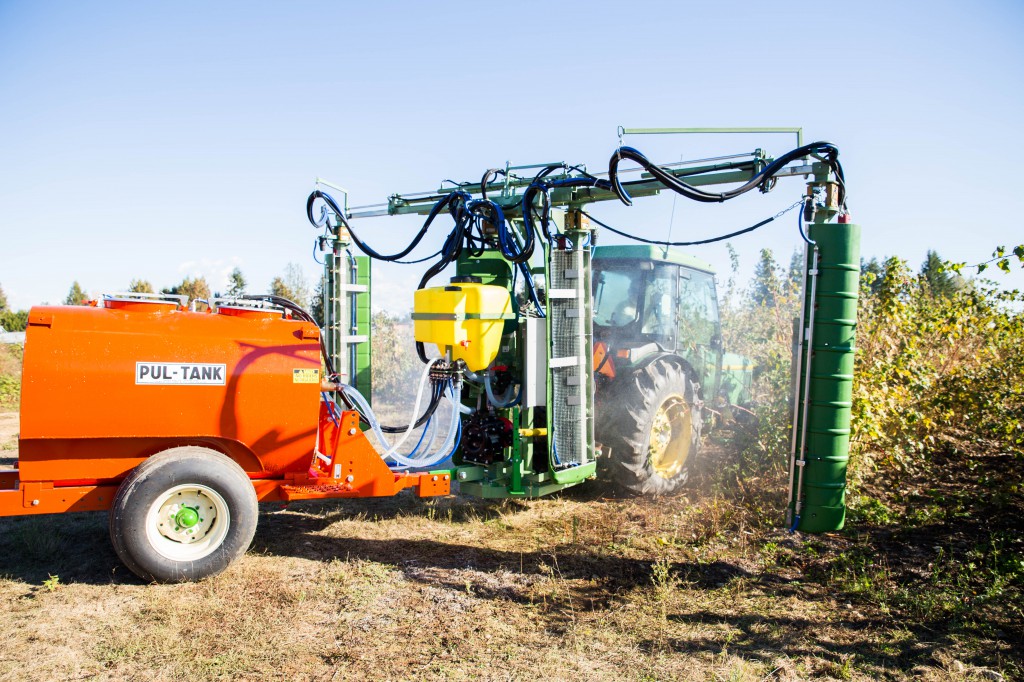By Cate Pedersen
Any spray drift means that it’s not working properly and so efficiency is the name of the game.
In January of 2017, The Pacific Agriculture Show hosted a wide selection of short courses produced jointly by the Lower Mainland Horticulture Improvement Association and the British Columbia Ministry of Agriculture.

I attended “Reducing Spray Drift with New Technology”, expecting a dry lecture about expensive spray applicator prototypes that might be in future development somewhere in the world; but I got schooled on what farmers could be doing now to help save them money, time and labour—not to mention avoid confrontations with neighbours over pesticide application spray drift.
I certainly didn’t expect to enjoy the 30-minute presentation, but the humorous and highly engaging speaker, Dr. Andrew Landers, Senior Extension Associate of Cornell University, College of Agriculture and Life Sciences, both educated and entertained the filled hall.
Landers’ focus is “to optimize pesticide use, improve deposition and reduce drift. To develop new methods to assist growers in applying pesticides whilst reducing environmental pollution and operator contamination.”
Landers exhibited a dry British wit in his opening by announcing, “You all know spray drift is a major issue; you don’t need me to reiterate why you shouldn’t do it. It’s sufficient to say: Why should the rest of society put up with your rubbish? No, thank you, very much, you can keep it!”
He went on to state that as business people, farmers should all be concerned about spray drift as “any spray drift means that it’s not working properly and so efficiency is the name of the game.”
As an agricultural engineer, Landers and his team at Cornell test different sprayers and collaborate with growers to try and improve spray application.
Landers joked about the challenges they have working with growers. “Sadly, many have different priorities than me. Theirs is to buy an F-150 pickup truck—King Ranch version, of course. They look at paying over $50,000 for a new sprayer that brings them zero income, and instead choose to use a legacy machine that’s over 35 years old.”
So Landers’ team explore converting older equipment for as little money as possible to help farmers improve sprayer efficacy. “There is a rise in retrofits of legacy sprayers,” Landers quipped.
“It is the air that is the main culprit,” said Landers. “We spend our days looking primarily at air flow, using sonic anemometers.” Adjusting the air blast setting on sprayers for different crops and canopy density is one of the first things growers should consider.
Landers referred to the “horseshoe vortex” and the “boundary layer effect”: when air is directed at a round object (like a blueberry), it curves around it and converges on the other side, carrying with it any particulate (like pesticide), depositing it behind the berry rather than on it. So, the lower the air speed, the better the deposition.
He also recommended reducing fan speed via the gear box and installing a hydraulic motor to drive the fan along with a flow control valve.

“You can imagine that when spraying blueberries and a jogger or school bus comes along, you can shut down the amount of air and can open it up again when necessary.”
Using drift measuring poles with spray cards attached, the team can see where spray lands. Reducing PTO speed and fan speed from 540 RPM to 405 RPM on a sprayer reduces drift on test cards placed four rows away from 10% to .04% which is a 60% difference. There is no cost to lower PTO and it saves fuel while decreasing drift. You can then tweak your pressure regulator if necessary.
Landers also showed images of a “Cornell doughnut”, a sheet of plywood with a hole cut into it to reduce air intake on older model sprayers. “Growers are our greatest inventors,” Landers mused as he described how after seeing the Cornell contraption, one fellow went on to improve the design by overlapping two plywood circles with holes that could be counter-rotated like a fireplace damper.
Studies about the effectiveness of various deflectors and towers that can be attached to sprayers to direct spray horizontally, ensuring more effective deposition, were also shown during Landers presentation.
Trials conducted by the Cornell team showed that there is less upward drift and more targeted application using tunnel sprayers or recycling sprayers as opposed to conventional sprayers like vertical boom sprayers.
Drift can be reduced by 95% and a 30% reduction in your spray bill can be achieved when technology and effective equipment is utilized. “It’s better logistics too,” said Landers. “Because you’re not having to refill so often, you therefore spend more time spraying.”
“The disadvantage of course is the capital cost,” Landers admitted. “But you have to outweigh the savings.”
There are grants available in the US to update equipment and Landers mentioned that Growing Forward 2 here in BC would consider applications for grants to help with upgrades.
Landers informed us we could visit the IMR Equipment booth at the event to view a LIPCO recycling tunnel sprayer on display—which I did following the lecture and learned even more about sprayer conversion.

Landers encouraged experimenting with your calibration for best results. By changing nozzle orientation and using a patternator, Landers’ team could balance out the effects of the air in a sprayer—another zero-cost fix. Instructions on changing nozzles and building your own patternator can be found on Landers’ website and in his paper entitled “What’s Your Orientation?”
We were reminded not to find the biggest and strongest operator on the farm to force the nozzles if they had been gummed up with pesticide residue, but to spray the nozzles with WD40 and leave overnight, then find the smallest, weakest operator to give them a gentle adjustment.
Landers wrapped up by driving home his 3 main recommendations:
- Select the right nozzle
- Shut down the air
- Consider tunnel sprayers
For more information, you can peruse the links here and on YouTube you can find Calibration of airblast sprayers for vineyards. You can also find Dr. Landers’ book on effective vineyard spraying which is also applicable to blueberry and raspberry growers here.












